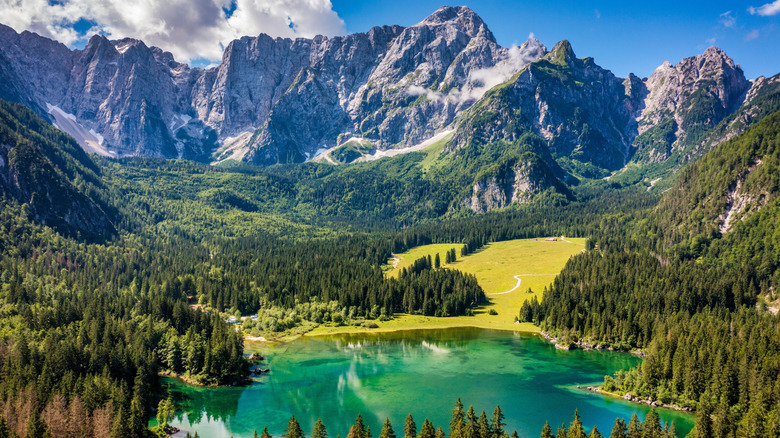A Pair Of Postcard-Perfect Lakes In Italy's Julian Alps Are More Intimate Than Over-Touristed Lake Como
Lake Como is one of the undisputed gems of Italy. It draws an estimated 1.4 million visitors each year with its slender arms of glittering water, which poke through into the high Alps, past romantic towns like Bellagio, up to ski fields and hiking ridges along the Swiss border. Sounds idyllic, eh? But what if there were lakes just as stunning, just as pristine and perfect, and just as hemmed in by jagged mountains, only with a fraction of the crowds? Well ... there are. They go by the name of Laghi di Fusine.
Keen-eyed students of the Italian language will notice that's a plural, for there's not just one, but two lakes that come under the Fusine banner. They reside roughly 3,000 feet up in the far eastern reaches of the Italian mountains, almost as far as it's possible to go before hopping over into Slovenia — the international border rests on a ridge just above the lakes. There's Lake Inferiore, the smaller and lower of the duo, and Lake Superiore, the larger and higher.
You can see both in a single day and get the same awesome mountain experience offered by other Italian waters like Como and Garda. That means soaring summits shrouded by clouds, reflections of mighty peaks in the inky water, and wonderful hikes through alpine woodlands. The closest airport to the lakes is in the undiscovered Slovenian capital of Ljubljana, around a one hour and 15-minute drive to the southeast. It's also possible to fly into Trieste, one of Italy's most under-the-radar towns, and drive north from there for a little over 2 hours.
The natural, untouched majesty of the Fusine Lakes
While Lake Como enjoys its place on lists of Italy's top bucket-list destinations, the Fusine Lakes are distinctly absent from most travel write-ups. But therein lies one of the great charms of these shimmering waters. Yes, there are reports of some crowds on the trails in the midst of peak summer, but the very fact that they aren't major hotspots should help to keep things serene, uncrowded, and natural.
One way to channel that intimate vibe is to swap out sweaty hikes for a day on a classic rowing boat. They're available for rent all summer from a dock on Lake Inferiore. Alternatively, stroll the lakeside paths to find quiet picnic spots with views over the craggy Alps. Didn't pack any food? No worries: Albergo Capanna Edelweiss is a highly rated mountain refuge where you can sample local Friuli-Venezia Giulia cuisine at a prime location on the edge of the lower lake.
If you really want to escape civilization, consider a trip to the Fusine in the depths of winter. Yes, the months of December and January do bring cold weather — some of the coldest weather in the whole of Italy, no less — but they also thin the crowds. Pack the snowshoes to hike through pillows of white stuff in the ice-caked forests around the lakes then, or simply drive up to appreciate visions of the frozen lakes and the frosted mountains behind.
Hiking around the Laghi di Fusine
Planning a hike? The main route to mark on the map is the circuit trail that links both lakes, starting at the parking lots beside the upper lake. In total, it covers just shy of 2.5 miles as it weaves an eight-shape around the bodies of water. Doing this one means you'll get stunning views of the 8,786-foot-high Mangart massif, one of the tallest peaks in the Julian Alps, the whole way along, ducking in and out of forests on semi-rocky trails beside the lakeside.
If you've got plenty of energy and an appetite to get stuck into the mountains, why not consider the longer, more challenging path up to Rifugio Zacchi? It's a 7-miler that lofts you more than 2,000 feet above the Fusine Lakes to a hut that hides in the forests, clutching the edge of the Mangart mountain. It goes through thick woods, offering occasional views of the peaks through the trees. At the finale, you can reward yourself with hearty local cuisine in the form of polenta and mountain sausages courtesy of the hut's onsite kitchen.
The summer months are high time for hiking around the Fusine Lakes, though the trails will be busiest between June and August. You can wait for the quieter time of autumn, which also ushers in gorgeous color-changing forests. Spring means wildflowers but also the chance of some snow remaining on the paths.


